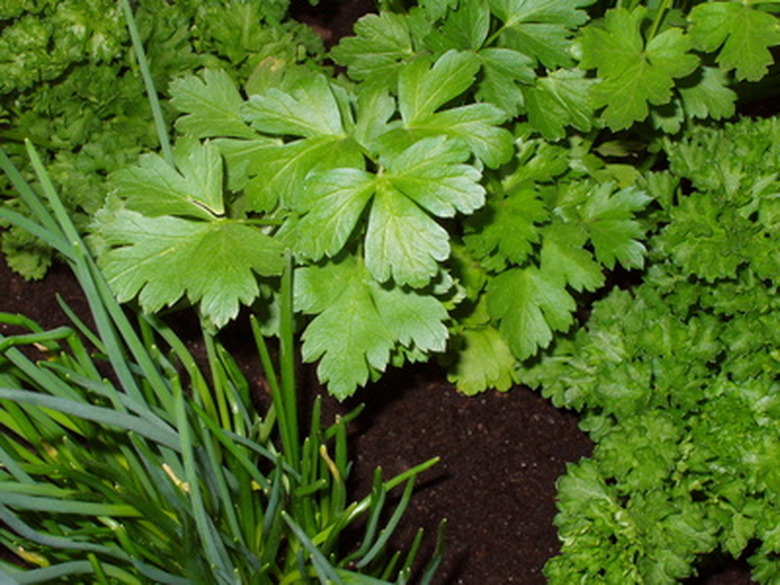How To Grow & Propagate An Artemisia Plant
Things Needed
- Artemisia cuttings
- Snips
- 4-inch pots
- Planting mix
- Rooting hormone powder
- Tablespoon
- Sheet of paper or paper towel
- Chopstick or pencil
- Trowel
Artemisias are a large variety of plants that are grown for their aromatic and attractive, gray-green foliage. According to Iowa State University, the most commonly grown artemisia is the variety artemisia schmidtiana, or as it is more commonly called, silvermound artemisia, wormwood or nana. All varieties of artemisia have the same requirements for growing: good drainage and plenty of sunlight. Propagating artemisia is easily accomplished by softwood cuttings in early summer.
Propagating Artemisia
Step 1
Cut off several sections from an artemisia plant. Try and cut off sections that have some new growth at the tips. Each section should be about 3 to 4 inches long.
- Artemisias are a large variety of plants that are grown for their aromatic and attractive, gray-green foliage.
- All varieties of artemisia have the same requirements for growing: good drainage and plenty of sunlight.
Step 2
Fill 4-inch pots with a good quality potting mix. Then, dampen the growing media. Pour water into each of the 4-inch pots until the growing media is well moistened.
Step 3
Measure out approximately 2 tablespoons of rooting hormone powder. Place the hormone powder onto a sheet of white paper, or a paper towel.
Step 4
Dip about 1-inch of the cut end of each artemisia into the rooting hormone powder.
Step 5
Poke a 1-inch deep hole in the center of each of the 4-inch pots using a pencil, chopstick or other similar object.
- Fill 4-inch pots with a good quality potting mix.
- Poke a 1-inch deep hole in the center of each of the 4-inch pots using a pencil, chopstick or other similar object.
Step 6
Set an artemisia cutting into one of the holes in a 4-inch pot. Hold the artemisia cutting while you pinch soil in and around the artemisia cutting.
Step 7
Set each of the 4-inch pots in an area in your home where they will remain undisturbed while the artemisia cuttings take root. Keep the soil moist, but not drippy wet. Let the soil dry out a little between waterings. Provide plentiful light, between 8 and 10 hours daily (avoid direct sunlight which can cook the artemisia cuttings). The temperature needs to remain consistently between 60 and 70 degrees Fahrenheit. The artemisia should take root and begin growing within three to four weeks, depending on conditions.
- Set an artemisia cutting into one of the holes in a 4-inch pot.
- Set each of the 4-inch pots in an area in your home where they will remain undisturbed while the artemisia cuttings take root.
Step 8
Transplant the artemisia plants once they are well established and about 3 to 4 inches tall.
Growing Artemisia
Step 1
Choose a planting site for the artemisia plants that will provide full sun.
Step 2
Dig planting holes for the artemisia plants that are between 18 and 24 inches apart.
Step 3
Remove an artemisia plant from its planting pot. Tip the planting pot on its side. Push down along the rim of a 4-inch pot and remove the pot off the root system. Then place an artemisia plant into one of the previously created planting holes. Make sure it's sitting vertically in the planting hole while you push in garden soil to fill the planting hole full of soil.
- Transplant the artemisia plants once they are well established and about 3 to 4 inches tall.
- Dig planting holes for the artemisia plants that are between 18 and 24 inches apart.
Step 4
Pack the soil down around each of the artemisia plants using your hand or a trowel.
Step 5
Water the artemisia plants with approximately 1 quart of water. Then, water once a week until they become established and are drought tolerant. For maximum growth, do not fertilize artemisia plants as suggested by Iowa State University. Avoid over watering artemisia plants, which can cause the plant to lose growth in the middle.
Tip
To help keep artemisia plants compact and dense, shear the plants back 1 to 2 1/2 inches right before they flower, or right after they flower. Artemisia schmidtiana is hardy in the USDA Zones 3 to 7.
